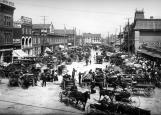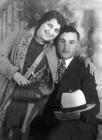1
We know very little about the very earliest Jewish settlers in Bytown, which in 1855 became incorporated as the City of Ottawa. The 1861 census reveals that the By Ward was home to a Jeweler called Bebe, his wife and their three children and a fellow Jew from Poland by the name of N. Samuel. Although Samuel lived in the By Ward, he worked as a store keeper in the neighbouring Wellington Ward. Moses Bilsky lived in Ottawa from 1857 to about 1860, but he had left for the gold fields in British Columbia at time the census took place, returning in 1881.Ottawa was a busy place in the 1860's primarily due to the building of the Houses of Parliament and the ongoing lumber business that was responsible for its rapid growth. The By Ward market, situated between the Rideau Canal and the Rideau River at the Ottawa River was a natural place for commercial enterprise of all kinds. The 1881 census reveals 16 Jewish people in Wellington Ward while only 4 people were in the By Ward: David Jacobs (agent) and Rebecca and Louis Levy (tobacconist) along with their baby. This fledgling Jewish community grew to approximately 30 families by 1900. Out of a total population of 392 Jewish people in the City of Ottawa, the 1901 census shows that 160 Jews lived in the By Ward.
Michael Freedman describes the market in an audio recording in this storyline, "the By Ward Market in the 1890's and early 1900's consisted mostly of farmers marketing their produce direct to the retailers and consumers. Many farmers who drove their wagons from distant points remained over night at nearby hotels." Most of the structures were of wooden construction in the earliest period. Fire was a constant fear and numerous fires did occur in the Market area especially before a municipal water system was built. The city passed a by-law in 1860 forbidding wooden structures in this area due to the number of fires resulting in loss of life and property. Brick and limestone structures replaced wooden construction except for outbuildings such as stables and storage sheds. Four market buildings were located at George and York Streets that burned before the first brick structure was erected in 1927. In 1977 this building was totally renovated but it remains the historic centrepiece of the present day "Byward" market.
A great number of Jewish immigrants looking for social stability and economic opportunity arrived in Ottawa in the 1920's. The Jewish population in Ottawa swelled to 3,316 by 1931. Many of the Jewish shop owners who had established themselves in Lowertown during the 1930's were photographed by Hugo Levendel, himself a newcomer to Canada. His photographs form a lasting record from this time period and many are included in this exhibit. Sol Gunner grew up on Murray Street alongside many other Jewish families such as the Levine's, the Nadrich family, the Glustein's, the Pleet's and Applebaum the tinsmith. He agreed that you didn't really have to leave Lowertown in the 1940's - except perhaps to buy a car - because you could find anything you needed there.
Jonathan Freedman tells the story in an audio clip in the Byward Market Street Storyline about how his Grandfather Michael Freedman immediately recognized that new supermarkets being established in the United States in the late 1940's would soon come to Canada. They would be forced to change their own business model as produce wholesalers that supplied numerous small grocers in the Byward Market and throughout Eastern Ontario. Similarly, Lawrence Freiman recognized that with the expansion of the City of Ottawa in the 1950's, he would have to open branches in the East end and throughout the Ottawa Valley to remain competitive. These two successful, second generation Jewish businessmen were ahead of the massive changes to the wholesale and retail industries that occurred as a result of post-war economic activity.
The Byward market and all of Lowertown (roughly the area East of Sussex and North of Rideau) was home to the Jewish community from the turn of the twentieth century until the 1960's. The winds of change that were all over North America found their way to Ottawa and the suburbs beckoned. Many of the first generation Canadians now had children going off to University to become professionals. Few wanted to carry on working in the family business.
External forces were also at play here with an Urban Renewal project that brought demolition crews and new infrastructure projects to Lowertown and the Byward market in the 1970's. Frank Slover paints a vivid description of life on the market when his father operated Slover's Department store at the corner of York and William Street. He recalled that "when the Ottawa market became big enough for the large, national retailers to move in - Sears, Eaton's, The Bay - with their impressive buying power, it was the death knell of the mid-size to larger department stores".
Small family businesses were replaced by chic boutiques and trendy restaurants over the years. There are exceptions, such as Saslove's Meat Market run by the Deiner family, but most of the traditional, family run businesses are gone. Morley Goldfield recalled how his meat processing business and other neighbors along Murray Street were forced to close in an audio clip in this Storyline (attached to the photograph of construction of the new parking garage).
"Mr. Market", Irving Rivers was always a strong advocate for merchants in the Byward Market, serving as President of the Byward Market Merchants Association for many years. He felt that the market should retain its historic connection to the market farmers and fought to keep York Street open to traffic. Dina Edelson of Edelson's Jewelers was a vocal opponent of Rideau Centre and the glass bus mall that the City of Ottawa erected along Rideau Street in the 1980's. Phil Lazear worked at Morris Saslove Meats on George Street when these changes occurred. He commented that "it took about 2 years and everything went downhill. The Market was killed by ripping up George Street and the Rideau Centre killed our business."
The first murder of 2012 took place outside a night club on Dalhousie Street yet tourism is the main industry for the Byward Market today. East of the market there are still residential areas, but Lowertown today is a very different community than it was fifty years ago. In March 2012, David Reevely reported in the Ottawa Citizen that the City's planning committee agreed that "the city needs a vision for the Byward Market so that it doesn't lose its traditional niche as a food market and become purely an entertainment district". The article goes on to say that "The city and the merchants have struggled for years with the changing character of the Market, where food retailers have been gradually closing down and are frequently replaced by restaurants and clubs. Last summer, one of the two remaining produce stores shut its doors for good."
3
Irving Rivers Ltd. at the corner of Byward and Clarence Street8 September 1957
24 Byward Market Street, Ottawa, Ontario, Canada
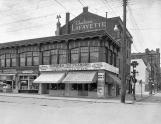 Credits:
Credits:Andrews-Newton
City of Ottawa Archives
CA-01507
7
Rideau Street showing Edelson's Jewellry Store Exterior20th Century, Circa 1950
24 Rideau Street, Ottawa, Ontario, Canada

8
Looking south on King Edward Avenue from St. Patrick Street20th Century, Circa 1965
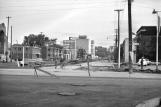 Credits:
Credits:Michel Lafleur
9
Looking north east during construction of new parking garage at York Street26 July 1974
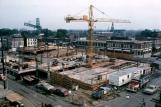 Credits:
Credits:Michel Lafleur
10
Cantor's Kosher Meat Market20th Century, Circa 1970
St. Patrick Street, Ottawa, Ontario, Canada
 Credits:
Credits:Michel Lafleur
11
Morton Baslaw's Second Stories No. 1, Restoration in the Byward, Ottawa20th Century, Circa 1970
 Credits:
Credits:Morton Baslaw OWS/OSA/CSPWC
